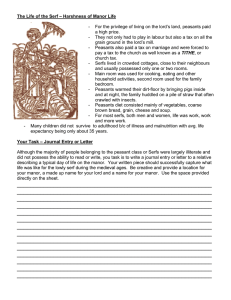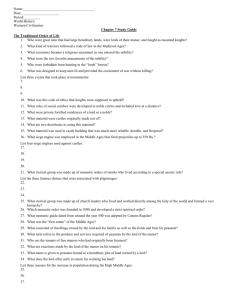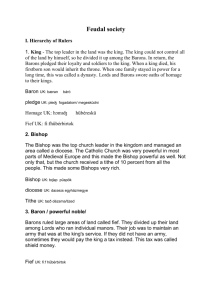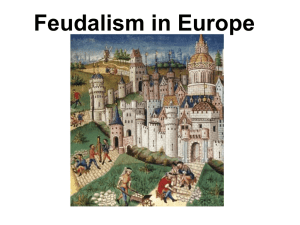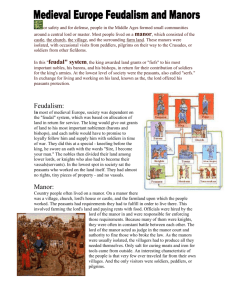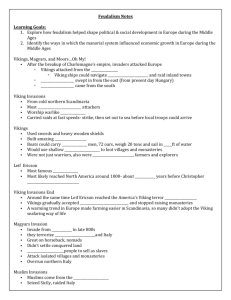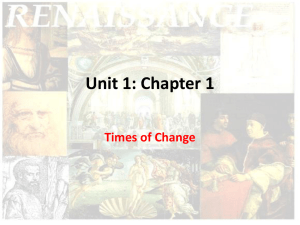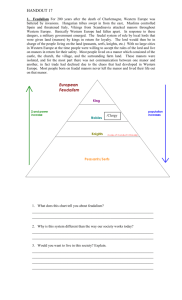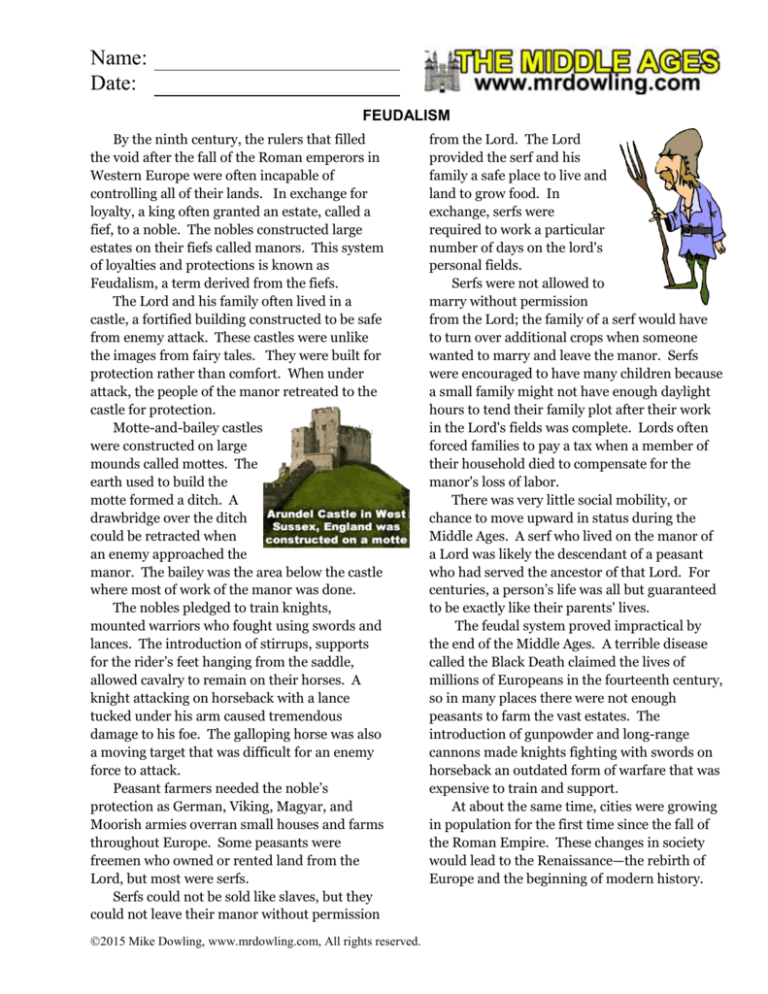
Name:
Date:
FEUDALISM
By the ninth century, the rulers that filled
the void after the fall of the Roman emperors in
Western Europe were often incapable of
controlling all of their lands. In exchange for
loyalty, a king often granted an estate, called a
fief, to a noble. The nobles constructed large
estates on their fiefs called manors. This system
of loyalties and protections is known as
Feudalism, a term derived from the fiefs.
The Lord and his family often lived in a
castle, a fortified building constructed to be safe
from enemy attack. These castles were unlike
the images from fairy tales. They were built for
protection rather than comfort. When under
attack, the people of the manor retreated to the
castle for protection.
Motte-and-bailey castles
were constructed on large
mounds called mottes. The
earth used to build the
motte formed a ditch. A
drawbridge over the ditch
could be retracted when
an enemy approached the
manor. The bailey was the area below the castle
where most of work of the manor was done.
The nobles pledged to train knights,
mounted warriors who fought using swords and
lances. The introduction of stirrups, supports
for the rider’s feet hanging from the saddle,
allowed cavalry to remain on their horses. A
knight attacking on horseback with a lance
tucked under his arm caused tremendous
damage to his foe. The galloping horse was also
a moving target that was difficult for an enemy
force to attack.
Peasant farmers needed the noble’s
protection as German, Viking, Magyar, and
Moorish armies overran small houses and farms
throughout Europe. Some peasants were
freemen who owned or rented land from the
Lord, but most were serfs.
Serfs could not be sold like slaves, but they
could not leave their manor without permission
2015 Mike Dowling, www.mrdowling.com, All rights reserved.
from the Lord. The Lord
provided the serf and his
family a safe place to live and
land to grow food. In
exchange, serfs were
required to work a particular
number of days on the lord's
personal fields.
Serfs were not allowed to
marry without permission
from the Lord; the family of a serf would have
to turn over additional crops when someone
wanted to marry and leave the manor. Serfs
were encouraged to have many children because
a small family might not have enough daylight
hours to tend their family plot after their work
in the Lord's fields was complete. Lords often
forced families to pay a tax when a member of
their household died to compensate for the
manor's loss of labor.
There was very little social mobility, or
chance to move upward in status during the
Middle Ages. A serf who lived on the manor of
a Lord was likely the descendant of a peasant
who had served the ancestor of that Lord. For
centuries, a person’s life was all but guaranteed
to be exactly like their parents' lives.
The feudal system proved impractical by
the end of the Middle Ages. A terrible disease
called the Black Death claimed the lives of
millions of Europeans in the fourteenth century,
so in many places there were not enough
peasants to farm the vast estates. The
introduction of gunpowder and long-range
cannons made knights fighting with swords on
horseback an outdated form of warfare that was
expensive to train and support.
At about the same time, cities were growing
in population for the first time since the fall of
the Roman Empire. These changes in society
would lead to the Renaissance—the rebirth of
Europe and the beginning of modern history.
Name:
Date:
Fill in the Blanks
During the Middle Ages, W__s__e__n European rulers often granted land to nobles. In exchange, the
noble pledged his l__y__l__y and provided the king with trained horsemen called k__i__h__s. This
system of loyalties and protections is called f__u__a__i__m.
The noble and his family often lived in c__s__l__s that were built for p__o__e__t__on rather than
c__m__o__t. The castles were constructed on raised mounds called m__tt__s. A vast estate called a
M__n__r surrounded the castle. As L__r__s of the Manor, the n__bl__s provided p__a__a__t
farmers with p__o__e__ti__n and land on which to grow food. The farmers r__p__id the noble by
w__r__i__g in his p__r__o__al fields in addition to f__r__i__g their land.
The feudal system ended in Western Europe by the end of the M__d__le Ages. Millions of
p__a__a__ts lost their lives from a widespread *i__l__e__s called the Black D__a__h, so there were not
enough workers to farm the M__n__rs. The cost of maintaining k__i__h__s became unnecessary once
rulers learned of g__n__o__d__r and long-range c__n__o__s. Meanwhile, as European cities grew in
p__p__l__ti__n for the first time since the fall of the R__m__n Empire, the feudal age gave way to the
R__n__i__s__n__e, the rebirth of Europe.
Answer in Complete Sentences
1. How did the introduction of the stirrup change military warfare during the Middle Ages?
2. Why were peasants of the Middle Ages willing to live on a Manor?
3. How were serfs different from other peasants during the Middle Ages?
4. Why did many peasants who lived on Manors desire large families?
*5. The text states "There was very little social mobility during the Middle Ages." What does this phrase
mean?
*This is a higher order learning question. You will earn credit for any reasonable answer.
2015 Mike Dowling, www.mrdowling.com, All rights reserved.

